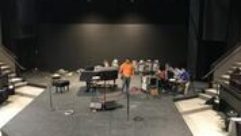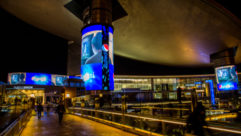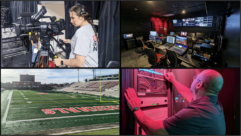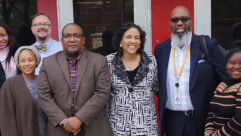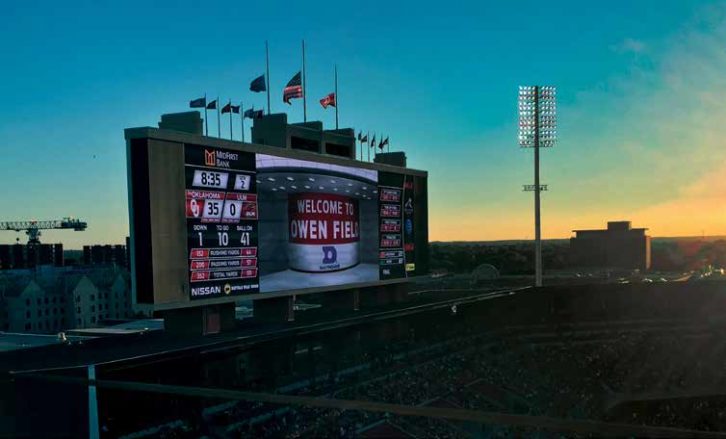
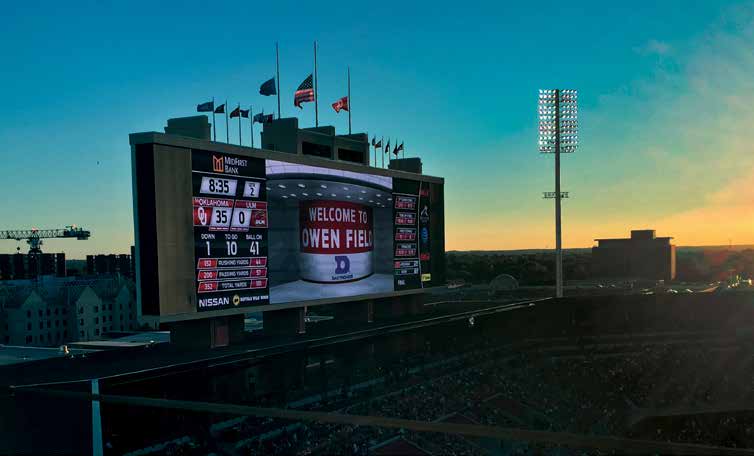
SVC: I know this is a whole science in itself to get one of these installed and figure the maintenance and get people trained on operating it. But this whole project didn’t just spring up overnight. It took some time to get the ball rolling. At Daktronics you’re working way ahead on getting approvals and having all of the dominoes lined up for these display projects. So when did the University of Oklahoma start up on the plan for this?
Perry Grave: Yeah, they started looking into doing this south end zone bowl-in as early as two or three years ago. I think that’s when they brought in an architect and started drawing up some plans and designs. And then they started getting us involved in the project probably a year and a half to two years ago helping out with specifications, weights, attachment methods; because they were in the process of designing the structure. At Owen Field, the display takes
What kind of improvement did they want over what they had before, just a bigger display?
They already had a pretty good-sized display there, but one of the things that they were lacking was the ability to go full native 1080 pixel-for-pixel resolution. In order to do that with this display they needed to grow it by about 15 feet in height. And then we were also able to tighten up the pixel resolution from a 16 mm to 13 mm. This also helped achieve that 1080 goal without having to gain as many square feet in height as we would have if we had been stuck with the 16 mm pitch.
It’s got to weigh tons. Was this on the same support that the previous display was on or did they have to build a whole new mounting structure for this one?
Yeah, this south end zone project was kind of a separate construction project and in this process they took down all the structure that was part of the old scoreboard in part of the stadium that had stood for a number of years. They did leave some of the lower bleachers if I recall correctly, but everything behind that is all new structure. So the new steel that the scoreboard is on now is all part of the general contractor’s design and it’s built right into the stadium.
From what I’ve seen, the new display takes the whole south end of the stadium and it must be at least as wide as the field.
Yeah, it’s 167…168.8 feet wide. And then on either side there’s sound cabinets that are about 40 feet wide. So overall you add 80 feet to that, it pretty much fills that end zone for sure.

So in planning for this I’m sure there was a lot of coordination going on to make sure the new stadium structure would fit and hold the weight of this monster.
We got involved early on and coordinated with the architects and general contractors. They do have catwalks on the back side of this. We helped them in the design of where those catwalks needed to go in relation to where the board pieces would be installed so that serviceability is pretty easy for this display. There’s a stairwell that they access up in the base of the display and they go up. It’s like an actual staircase, not a ladder. And then there are five different levels of catwalks on the back so they can access the new display at any point.
Daktronics has been mighty busy installing these things. It sort of looks like there might be a massive case of one-upmanship going on. Is there a facilities race going on in college sports stadiums?
I think the main thing driving some of these are the student athletes and recruitment. When these student athletes are coming to these facilities and they’re taking their tours they’re looking for these kind of amenities. Not just the video boards, but the stadium capacity, the locker rooms, weight rooms, these other things that are part of the stadium improvement packages. But I think I’ve heard some of them say that they definitely like seeing themselves really, really big on the screen during replays so that is a factor.
For these installations they have to get the video signal to the display from the control point so how do you do that? Is it on fiber or copper twisted pair with HDBaseT or how does it work?
We feed all of our data to the display through fiber optic. We use multi-mode fiber. When we’re running fiber we run plenty of extras. I think we ran 24-core fiber out there and we’re using maybe six of those. The basis for that is some of it is redundancy. We want to make sure that if there is a failure to one of those fibers we’ve got plenty of extras to tap into. The other thing we just learned over the years is it will get used. There’s never an overabundance of fiber on these jobs. If there is any opportunity we have to pull extra, we like to take care of that for the customer. It’s cheap to do it now. It’s more expensive to come back and do it again.
And this thing, I know it’s out in the sun. It probably gets direct sunlight and the temperature range during football season in Oklahoma runs from arctic to hot as blazes so how do you control the temperature of the display?
Inside the displays we’ve got fans that are mounted to the cabinets that can pump air through the cabinets and circulate air. And then we’ve also got fans individually on each module in the board. All these fans are run off of thermostats. And then if the temperature cools off, the fans shut off. When we first started with these, the LED technology required the use of air conditioners to maintain that temperature at a much lower level. But with advancements in LED technology and other circuitry that’s in the boards, we’re able to do away with the air conditioning and just use the ventilated air.
Yeah, I would think that the air conditioning systems pulled a lot more power, too.
Yeah, it pulled more power and it added another level of maintenance. If you can imagine the air conditioning systems in your home and the filter changing and the annual maintenance that had to occur with those.
How long did this whole thing take from the time you got in there to start work on it till you had your test run and the final rehearsal before the first home game of the season?
We got released to go on the jobsite in about mid-July and we were fired up and ready to go by the end of August. We’d done some testing and we were ready for them to use the display. Because this project was in conjunction with other building that was going on, we really had to coordinate with the general contractor and other trades because space was a premium here and to be able to bring multiple cranes in was just not going to be possible. We had to coordinate and schedule crane time. So we were able to get a two-week window where we could actually access the crane and install all of our pieces. The rest of it, hooking the electrical up, we could do from the catwalks.
I’m sure there are some sleepless nights getting each deadline met but all worth it in the end.
Yeah. I remember when we first fired up we were doing some nighttime testing and it was an overcast night, real low clouds. We were getting reports from people that were 32 miles away that could see the display driving down the highway. That was pretty cool too.
What were the official specs on this thing? What are the actual measurements?
Sure. The physical dimensions of the display are 46.8 feet tall by 166.8 feet wide. It’s 1092 pixels tall by 3,892 pixels wide. It’s on 13 millimeter line spacing. With this size it allows basically for two true 1080HD videos to be side-by-side on the board and the university actually uses it for that a lot of times during instant replays or pregame shows. They’ll put up other games, out of town games, one on each half, and show them when a crowd is coming in. So they make some pretty good use out of that. The average power this season is about 60,000 watts. Viewing angles are about 160 degrees on this board. One of the things that’s really nice about this HD product is it gives you these real wide viewing angles.
How does the 13HD compare to a 16, 20 and 26HD?
The biggest advantage for them to go at 13 on this project is to be able to get to 1080 without going extremely big physically on size. Just by bringing those lines closer together you can get to that number in a smaller footprint than you could with a 16, 20, or even a 26. So that was the biggest advantage that they got from using this technology. And the 13HD has kind of become our standard across the industry. Most NFL stadiums that have put in our product have gone with the 13HD. It just kind of maximizes that resolution pixel density that they’re looking for.
The games here are televised so I was curious as to what it would look like especially with a panning camera like on the kickoffs. Have you had the opportunity to see what that looks like?
You know I have not seen this particular one on TV yet, but I’ve seen other 13HD product on TV at some other stadiums and it looks great. We’ve done a lot of research and development to get the refresh rates and everything to the point to where cameras don’t pick up some of the effects that you see like in the old days with computer screens and things like that. And it’s been an evolution over the years with slo-mo and super slo-mo cameras and that’s had to adapt with that. So I’m confident that it will look really good.
At some point you have to hand the keys over to the local stadium crew and let them run with it. So what goes into the training of the crew to set this up and control it for the games?
Typically after a display is installed we’ll send in trainers to train on the control systems and we’ll also send in people to train on maintenance. Some facilities will take the responsibility to maintain their own displays. Others will rely on us to do it. But we still do a certain level of training just to give them familiarity with the boards and pieces like that.
And I would think there are backups and secondary capabilities in there with some sort of dual connections that it can failover to if something happens.
Yeah. All of the control gear has a primary and a backup that are accessed through an AV switch so it’s as simple as flipping a switch. In the event that they should have a problem with one of the pieces they just flip the switch and they’re running on their backup. With a system this size that ends up being pretty cheap insurance.
You mentioned the catwalks and you made sure that they were built into the right places for the tech people to access the display structure. What does that look like?
It’s simpler than you think. Each module has three connections on it; a power cable, a data in, and a data out. So it makes it really simple for people to go in and swap out parts.
Didn’t you also put a big display in their new weight room?
Correct. That is something kind of new that we’re seeing a lot more of. But inside their weight room training area we’re putting in an LED board that’s roughly 10 feet by 36 feet. And the intention there is they’ll run TV programs on there. They can put up training schedules and update those daily and make them interactive as well with the touchscreen panel that will be mounted to the wall. Where players come in and they can punch in their name and ID and it will pull up their training schedule and put it up on the screen for them. And then they are able to put multiple TV programs up on it at the same time as they’re going through their training schedule.



